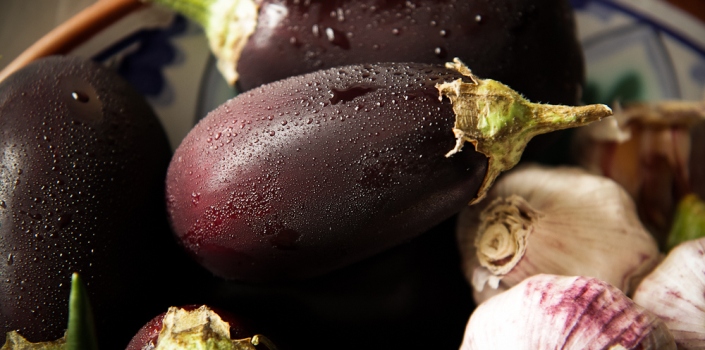All About Aubergine

As summer turns to autumn, I like to make the most of the vegetables reminiscent of Mediterranean summer holidays that bring back the warmth of taverna suppers. You'll often find aubergine at our cookery classes as they're grown in a huge array of varieties around the world and are delicious and versatile. They will soak up treasured bottles of olive oil, marry well with capers and olives, and they combine beautifully with spices. They can be simply griddled, turned into a smoky-flavoured dip, or added to hearty stews or curries for a velvety ‘meaty’ texture.
Aubergines are related to peppers, potatoes and tomatoes; all members of the Solanaceae nightshade family. Their shape can vary from oval to globe-like with colours ranging from purple through violet, often with variegated stripes, or they can be pure white or cream. In the countries of Southeast Asia you will find a greater variety of shape, size and colour – from the small yellow Thai aubergines to the tiny pea-sized Indian ones – which are prized for their bitterness.The most common aubergine is the familiar glossy, deep purple variety we see on shelves in the UK. They love sunny growing conditions and are best grown under glass in Britain. When shopping, look for lovely shiny specimens with a heavy feel and taut skin that gives just slightly when pressed. They should be stored in a cool dark place, and never in plastic bags which cause them to sweat.
Aubergines are always cooked as they taste unpleasant raw. Some people like to "de-gorge" or salt them before cooking to remove bitterness, but I find that modern black varieties don't need to be salted. As aubergines cook they absorb flavours like a sponge! This makes them ideal for ingredients such as garlic, herbs, and spicy chili. They absorb oil at an alarming rate so use it sparingly when cooking!
Our favourite simple way of cooking aubergines is cutting them into slices or chunks with a splash of oil, which you can toss the aubergine in before roasting, griddling or stir-frying. Whichever way you cook aubergines make sure they are really well cooked, and have lost their whiteness, turned dark and become unctuously soft and juicy.

Picture by Chris Mosler of Thinly Spread.
7 Favourite Aubergine Recipes
- Aubergine Roulé with Tomato & Basil Vinaigrette
- Roasted Late Summer Salad
- Ratatouille
- Paneer Baigan
- Date and Aubergine Tagine
- Chakchouka
- Burmese Aubergine Curry
We'll be sharing more aubergine recipes in our Meat Free Monday Recipe slot from next week so keep your eyes peeled! In the meantime, go and buy some of these beauties and tell us what you cook up with them!

Picture by Rob Wicks of Eat Pictures.
Have you had a look at the cookery courses we have lined up for autumn? We do hope you'll join us soon!
Find us on Facebook, Twitter, Pinterest and Instagram where we are chatting about all things foodie and, if you like this post, please share it! To keep up to date with events and goings on at the cookery school sign up for our newsletter.



